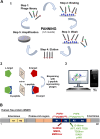Tau Aggregation Inhibiting Peptides as Potential Therapeutics for Alzheimer Disease
- PMID: 35596819
- PMCID: PMC10006036
- DOI: 10.1007/s10571-022-01230-7
Tau Aggregation Inhibiting Peptides as Potential Therapeutics for Alzheimer Disease
Abstract
Alzheimer disease (AD) is the most common progressive neurodegenerative disorder. AD causes enormous personal and economic burden to society as currently only limited palliative therapeutic options are available. The pathological hallmarks of the disease are extracellular plaques, composed of fibrillar amyloid-β (Aβ), and neurofibrillary tangles inside neurons, composed of Tau protein. Until recently, the search for AD therapeutics was focussed more on the Aβ peptide and its pathology, but the results were unsatisfying. As an alternative, Tau might be a promising therapeutic target as its pathology is closely correlated to clinical symptoms. In addition, pathological Tau aggregation occurs in a large group of diseases, called Tauopathies, and in most of them Aβ aggregation does not play a role in disease pathogenesis. The formation of Tau aggregates is triggered by two hexapeptide motifs within Tau; PHF6* and PHF6. Both fragments are interesting targets for the development of Tau aggregation inhibitors (TAI). Peptides represent a unique class of pharmaceutical compounds and are reasonable alternatives to chemical substances or antibodies. They are attributed with high biological activity, valuable specificity and low toxicity, and often are developed as drug candidates to interrupt protein-protein interactions. The preparation of peptides is simple, controllable and the peptides can be easily modified. However, their application may also have disadvantages. Currently, a few peptide compounds acting as TAI are described in the literature, most of them developed by structure-based design or phage display. Here, we review the current state of research in this promising field of AD therapy development.
Keywords: Aggregation inhibitors; Alzheimer disease; Peptides; Tau; Tauopathies.
© 2022. The Author(s).
Conflict of interest statement
The authors declare that they have no competing interests.
Figures

References
-
- Aillaud I, Kaniyappan S, Chandupatla RR, Ramirez LM, Alkhashrom S, Eichler J, Horn AH, Zweckstetter M, Mandelkow E, Sticht H, Funke SA (2022) A novel D-amino acid peptide with therapeutic potential, designated ISAD1, inhibits aggregation of disease relevant pro-aggregant mutant Tau and prevents Tau toxicity in vitro. Alzheimers Res Ther 14:15 - PMC - PubMed
-
- Alzheimer A, Stelzmann RA, Schnitzlein HN, Murtagh FR (1995) An English translation of Alzheimer’s 1907 paper, “Über eine eigenartige Erkankung der Hirnrinde.” Clin Anat 8:429–431. 10.1002/ca.980080612 - PubMed
-
- Arendt T, Stieler JT, Holzer M (2016) Tau and tauopathies. Brain Res Bull 126:238–292. 10.1016/j.brainresbull.2016.08.018 - PubMed
-
- Barghorn S, Davies P, Mandelkow E (2004) Tau Paired helical filaments from Alzheimer’s disease brain and assembled in vitro are based on β-structure in the core domain †. Biochemistry 43:1694–1703. 10.1021/bi0357006 - PubMed
-
- Braak H, Braak E (1991) Neuropathological stageing of Alzheimer-related changes. Acta Neuropathol 82:239–259 - PubMed
Publication types
MeSH terms
Substances
Grants and funding
LinkOut - more resources
Full Text Sources
Other Literature Sources
Medical
Research Materials

